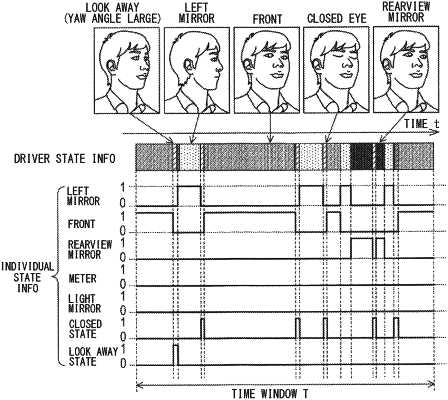| CPC B60W 40/09 (2013.01) [G06V 20/597 (2022.01); G06V 40/168 (2022.01); B60W 2540/225 (2020.02)] | 11 Claims |

|
1. A behavior recognition apparatus comprising:
an information acquisition unit configured to repeatedly acquire one or more than one primary informational item including at least one informational item selected from three informational items, the three informational items being (i) an informational item on a state of a vehicle, (ii) an informational item on a state of a driver of the vehicle, and (iii) an informational item on a state around the vehicle;
an information conversion unit configured to
extract one or more than one target state with respect to each primary informational item acquired by the information acquisition unit, and
generate a secondary informational item represented by two different values that express, respectively, (i) corresponding to the target state and (ii) not corresponding to the target state, the two different values being enabled to be added or subtracted;
an extraction unit configured to extract a determination information group using a time window from a plurality of the secondary informational items in time series generated by the information conversion unit;
an update unit configured to
define a behavior vector in which elements are respectively associated with driving behaviors of the driver while giving an initial value of the behavior vector, and
update the behavior vector by a correction amount of the behavior vector calculated by using the determination information group; and
a recognition unit configured to recognize the driving behaviors of the driver using the behavior vector updated by the update unit,
wherein:
the update unit is further configured to
calculate the correction amount of the behavior vector by using a regression function representing a relationship between (i) a feature amount calculated from the determination information group and (ii) the correction amount of the behavior vector, and
use a difference value between a pair of comparison data, which are two data extracted from the determination information group, as the feature amount.
|